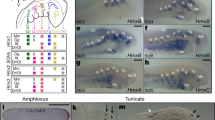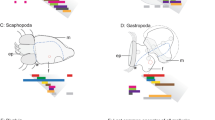Abstract
An orthologue of the COE family of helix-loop-helix transcription factors was recovered from the anthozoan Nematostella vectensis (Cnidaria). NvCOE has high sequence similarity to vertebrate and invertebrate orthologues in all three major functional domains of the protein. In situ hybridization studies show early expression through the cleavage period but transcripts are down regulated at gastrulation while remaining expressed at high levels only in the apical tuft of cilia at the aboral end of the planula larva. It is likely that one of the ancestral roles of the COE family of genes may have been in the development of chemosensory neurons.



Similar content being viewed by others
References
Bally-Cuif L, Dubois L, Vincent A (1998) Molecular cloning of Zcoe2, the zebrafish homolog of Xenopus Xcoe2 and mouse EBF-2, and its expression during primary neurogenesis. Mech Dev 77:85–90
Bridge D, Cunningham CW, Schierwater B, DeSalle R, Buss LW (1992) Class-level relationships in the phylum Cnidaria: evidence from mitochondrial genome structure. Proc Natl Acad Sci USA 89:8750–8753
Chia FS, Koss R (1979) Fine structural studies of the nervous system and the apical organ in the planula larva of the sea anemone Anthopleura elagantissima. J Morphol 160:275–297
Chia FS, Spaulding JG (1972) Development and juvenile growth of the sea anemone, Tealia crassicornis. Biol Bull 142:206–218
Collins AG (2002) Phylogeny of Medusozoa and the evolution of cnidarian life cycles. J Evol Biol 15:418–432
Crozatier M, Vincent A (1999) Requirement for the Drosophila COE transcription factor Collier in formation of an embryonic muscle: transcriptional response to notch signalling. Development 126:1495–1504
Crozatier M, Valle D, Dubois L, Ibnsouda S, Vincent A (1996) Collier, a novel regulator of Drosophila head development, is expressed in a single mitotic domain. Curr Biol 6:707–718
Degnan BM, Souter D, Degnan SM, Long SC (1997) Induction of metamorphosis with potassium ions requires development of competence and an anterior signalling centre in the ascidian Herdmania momus. Dev Genes Evol 206:370–376
Dubois L, Vincent A (2001) The COE—Collier/Olf1/EBF—transcription factors: structural conservation and diversity of developmental functions. Mech Dev 108:3–12
Finnerty JR, Paulson D et al (2003) Early evolution of a homeobox gene: the parahox gene Gsx in the Cnidaria and the Bilateria. Evol Dev 5(4):331–345
Hadfield MG, Meleshkevitch EA, Boudko DY (2000) The apical sensory organ of a gastropod veliger is a receptor for settlement cues. Biol Bull 198:67–76
Hagman J, Belanger C, Travis A, Turck CW, Grosschedl R (1993) Cloning and functional characterization of early B-cell factor, a regulator of lymphocyte-specific gene expression. Genes Dev 7:760–773
Hagman J, Gutch MJ, Lin H, Grosschedl R (1995) EBF contains a novel zinc coordination motif and multiple dimerization and transcriptional activation domains. EMBO J 14:2907–2916
Hay-Schmidt A (2000) The evolution of the serotonergic nervous system. Proc R Soc Lond Ser B Biol Sci 267:1071–1079
Kempf SC, Page LR, Pires A (1997) Development of serotonin-like immunoreactivity in the embryos and larvae of nudibranch mollusks with emphasis on the structure and possible function of the apical sensory organ. J Comp Neurol 386:507–628
Lacalli TC (1981) Structure and development of the apical organ in trochophores of Spirobranchus polycerus, Phyllodoce maculata and Phyllodoce mucosa (Polychaeta). Proc R Soc Lond Ser B Biol Sci 212:381–402
Liberg D, Sigvardsson M, Akerblad P (2002) The EBF/Olf/Collier family of transcription factors: regulators of differentiation in cells originating from all three embryonal germ layers. Mol Cell Biol 22:8389–8397
Medina M, Collins AG, Silberman JD, Sogin ML (2001) Evaluating hypotheses of basal animal phylogeny using complete sequences of large and small subunit rRNA. Proc Natl Acad Sci USA 98:9707–9712
Nielsen C (1999) Origin of the chordate central nervous system—and the origin of chordates. Dev Genes Evol 209:198–205
Odorico DM, Miller DJ (1997) Internal and external relationships of the Cnidaria: implications of primary and predicted secondary structure of the 5′-end of the 23S-like rDNA. Proc R Soc Lond Ser B Biol Sci 264:77–82
Pozzoli O, Bosetti A et al (2001) Xebf3 is a regulator of neuronal differentiation during primary neurogenesis in Xenopus. Dev Biol 233(2):495–512
Prasad BC, Ye B, Zackhary R, Schrader K, Seydoux G, Reed RR (1998) unc-3, a gene required for axonal guidance in Caenorhabditis elegans, encodes a member of the O/E family of transcription factors. Development 125:1561–1568
Rothenberg EV (2000) Stepwise specification of lymphocyte developmental lineages. Curr Opin Genet Dev 10:370–379
Vandermuelen JH (1974) Studies on reef corals. II. Fine structure of planktonic planula larva of Pocillopora damicornis with emphasis on the aboral epidermis. Marine Biol 27:239–249
Vervoort M, Crozatier M, Valle D, Vincent A (1999) The COE transcription factor Collier is a mediator of short-range Hedgehog-induced patterning of the Drosophila wing. Curr Biol 9:632–639
Vinson CR, Garcia KC (1992) Molecular model for DNA recognition by the family of basic-helix-loop-helix-zipper proteins. New Biol 4:396–403
Wainright PO, Hinkle G, Sogin ML, Stickel SK (1993) Monophyletic origins of the Metazoa: an evolutionary link with fungi. Science 260:340–342
Acknowledgements
This work was funded by grants from the NASA Fundamental Biology program, and the NSF.
Author information
Authors and Affiliations
Corresponding author
Additional information
Edited by D.A. Weisblat
Electronic Supplementary Material
Rights and permissions
About this article
Cite this article
Pang, K., Matus, D.Q. & Martindale, M.Q. The ancestral role of COE genes may have been in chemoreception: evidence from the development of the sea anemone, Nematostella vectensis (Phylum Cnidaria; Class Anthozoa). Dev Genes Evol 214, 134–138 (2004). https://doi.org/10.1007/s00427-004-0383-7
Received:
Accepted:
Published:
Issue Date:
DOI: https://doi.org/10.1007/s00427-004-0383-7




